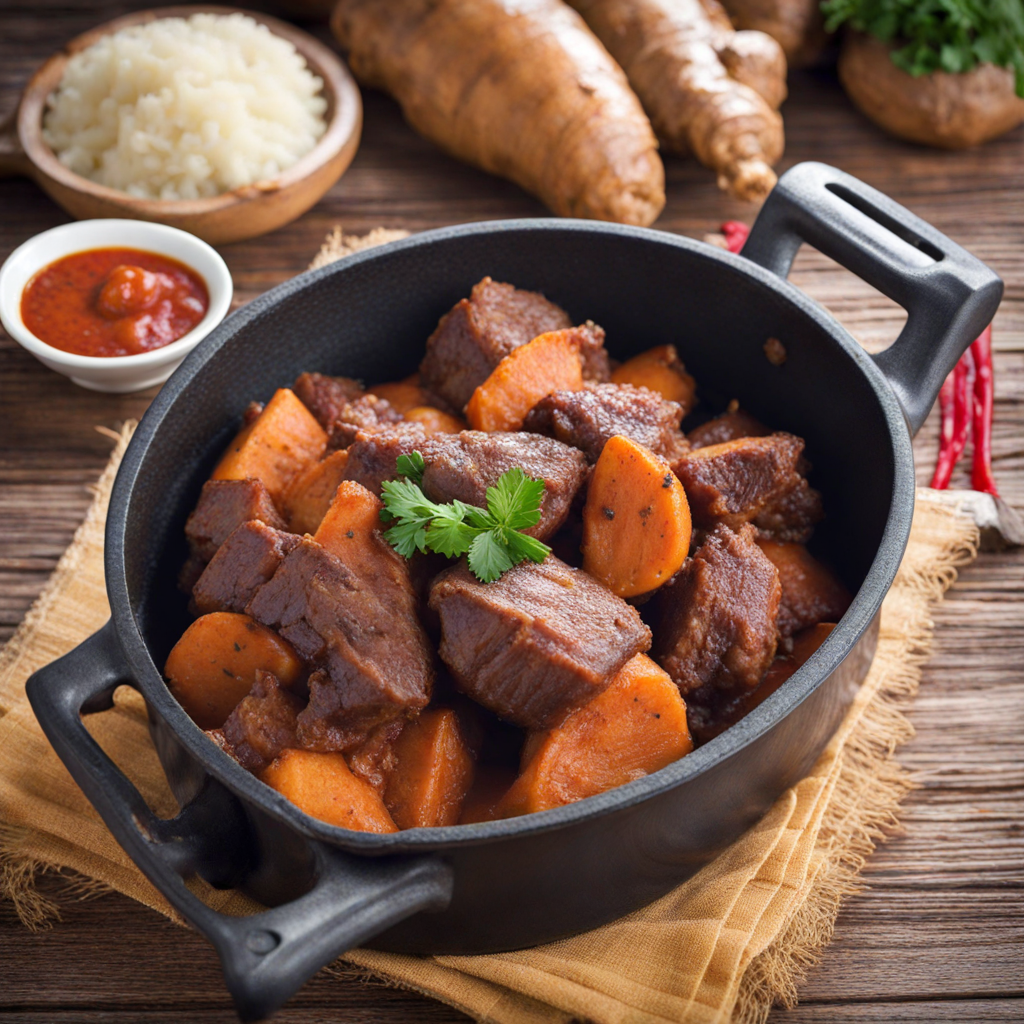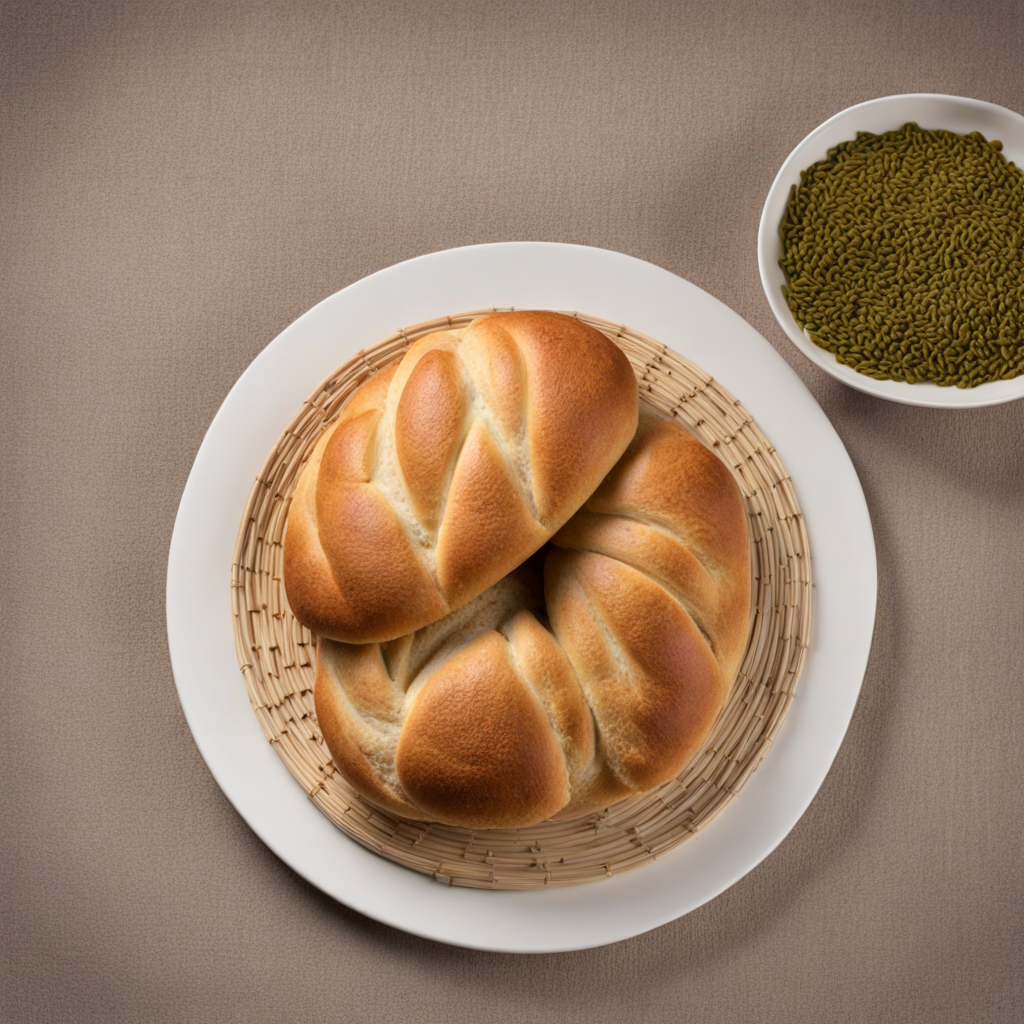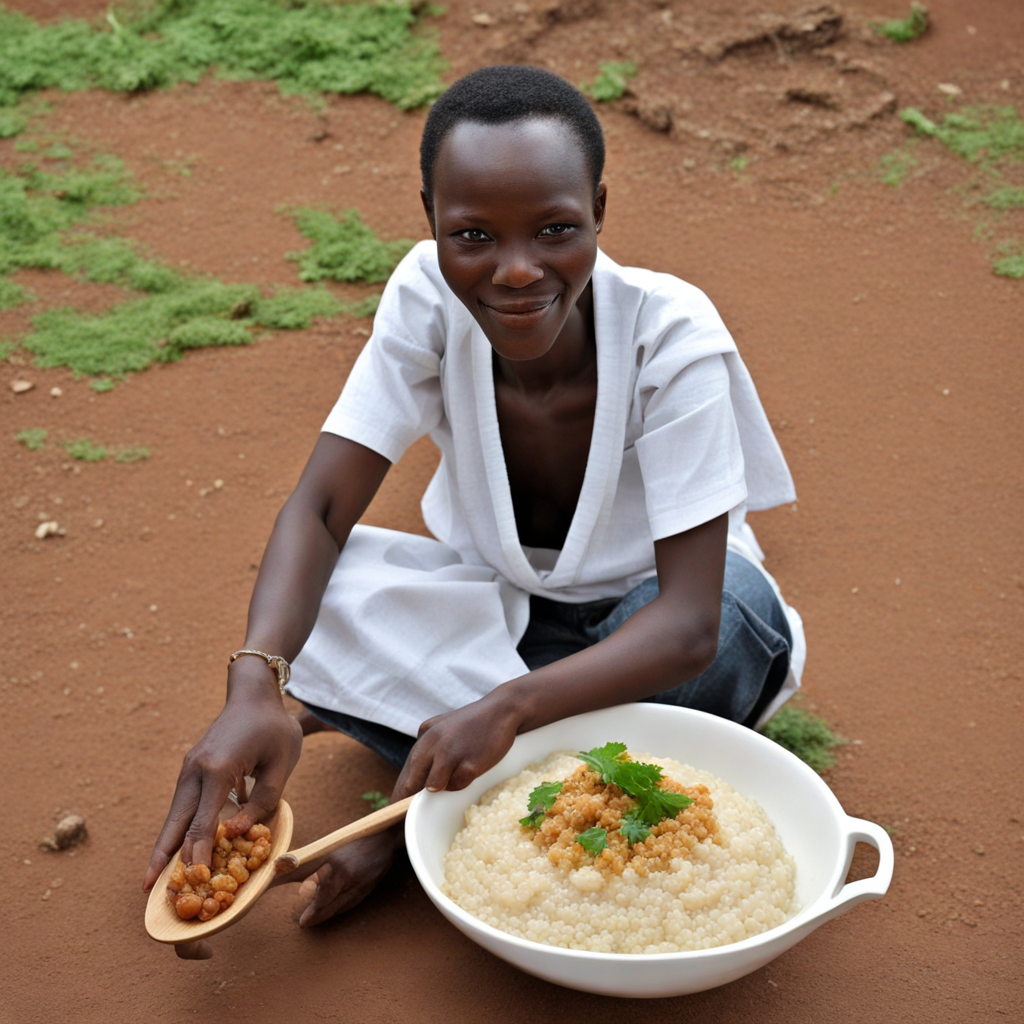Amateke na Nyama
Amateke na Nyama is a delightful Rwandan dish that showcases the country's rich culinary heritage. At its core, 'Amateke' refers to tender, boiled green bananas, often resembling plantains, which are a staple in Rwandan cuisine. These bananas are typically cooked until soft and then seasoned, providing a mild, earthy base that perfectly complements the robust flavors of the accompanying 'Nyama', or meat. The dish is a beautiful balance of textures, with the smooth and creamy consistency of the bananas juxtaposed against the savory, hearty meat, usually beef or goat, that is marinated and grilled or stewed to perfection. The preparation of Amateke na Nyama goes beyond mere cooking; it is a cultural experience. The bananas are often prepared with a touch of salt and sometimes served with a rich sauce made from tomatoes, onions, and local spices, enhancing the overall flavor profile. The meat, marinated with herbs and spices, is cooked until tender and infused with deep flavors, making it a favorite at gatherings and celebrations. The combination of these two elements on a plate creates a comfort food experience that is both filling and satisfying, inviting diners to savor each bite. This dish not only showcases the ingredients native to Rwanda but also reflects the communal spirit of the Rwandan people. Sharing Amateke na Nyama is often a communal experience, where friends and family gather around a table, enjoying the vibrant flavors and the warmth of togetherness. With its unique blend of flavors and textures, Amateke na Nyama offers a memorable taste of Rwandan culture, making it a must-try for anyone looking to explore new culinary landscapes.
How It Became This Dish
Amateke na Nyama: A Culinary Journey Through Rwandan Heritage #### Origins of Amateke na Nyama Amateke na Nyama, a delightful dish from Rwanda, embodies both the agricultural richness and the culinary traditions of the region. The term "amateke" refers to plantains, while "nyama" translates to meat, often beef or goat, reflecting a harmonious blend of the earth's bounty with the richness of livestock. The origins of this dish can be traced back to the agricultural practices of the Rwandan people, who have cultivated various crops, including bananas, for centuries. Rwanda's high altitude and fertile volcanic soil create optimal conditions for growing bananas. The indigenous communities recognized the nutritional value of bananas, which became a staple in their diet. Over time, cooking methods were developed to prepare these fruits, leading to the creation of dishes like Amateke na Nyama. The dish encapsulates the essence of Rwandan cuisine, where agriculture, livestock rearing, and community intertwine. #### Cultural Significance Amateke na Nyama is more than just a meal; it is a representation of Rwandan culture and identity. The dish is often served during communal gatherings, celebrations, and significant life events such as weddings, funerals, and harvest festivals. In Rwandan society, food plays a crucial role in bringing people together, fostering a sense of community and shared identity. In traditional Rwandan culture, communal eating is a cherished practice. Families and friends gather around a single pot, sharing not only the food but also stories, laughter, and companionship. Amateke na Nyama, with its robust flavors and hearty ingredients, serves as a centerpiece during these gatherings, symbolizing abundance and togetherness. The dish also reflects the agricultural calendar of Rwanda. The harvest season, marked by the ripening of bananas and the availability of livestock, is a time of celebration. Amateke na Nyama serves as a reminder of the connection between the people and the land, emphasizing the importance of sustainable agriculture and respect for nature. #### Development Over Time The preparation of Amateke na Nyama has evolved over generations, influenced by changing agricultural practices, globalization, and cultural exchanges. Traditionally, the dish would be prepared using simple, locally sourced ingredients. Plantains would be boiled or steamed until tender, while the meat would be marinated with spices and cooked to perfection, often using traditional clay pots over an open fire. As Rwanda transitioned through various historical phases, including colonialism and the post-genocide era, the culinary landscape also adapted. The introduction of new cooking techniques, spices, and ingredients, alongside the influence of neighboring countries, has enriched the preparation of Amateke na Nyama. For instance, the use of tomatoes, onions, and other vegetables has become more common, adding depth and complexity to the dish. In contemporary Rwanda, Amateke na Nyama has gained popularity not only within the country but also among the Rwandan diaspora and international food enthusiasts. Restaurants and culinary festivals celebrate this traditional dish, showcasing its unique flavors and the story behind it. The dish has also been embraced by modern chefs who experiment with presentation and cooking methods while respecting its cultural roots. The rise of the farm-to-table movement has further emphasized the importance of local ingredients in preparing Amateke na Nyama. Chefs and home cooks alike are increasingly prioritizing fresh, sustainably sourced produce and meats, reflecting a growing awareness of the environmental impact of food choices. This shift not only honors the traditional practices of Rwandan cooking but also supports local farmers and communities. #### Amateke na Nyama in Contemporary Rwanda Today, Amateke na Nyama is celebrated as a symbol of national pride and cultural heritage. Rwandans take great pride in their culinary traditions, and this dish is often featured in cultural events and festivals that promote Rwandan identity. Additionally, the dish is frequently served in restaurants that aim to provide an authentic taste of Rwandan cuisine to both locals and tourists. In the realm of culinary tourism, Amateke na Nyama is often highlighted as a must-try dish for visitors. Food tours and cooking classes that focus on traditional Rwandan cuisine frequently include sessions on how to prepare this dish, allowing participants to connect with the culture on a deeper level. This not only helps preserve the culinary heritage but also fosters a greater appreciation for the diversity of Rwandan food. #### Conclusion Amateke na Nyama stands as a testament to the resilience and creativity of the Rwandan people. From its humble beginnings as a staple food to its current status as a celebrated dish, it reflects the evolution of Rwandan society and its deep-rooted connections to the land. The dish is not merely a representation of ingredients but a cultural artifact that tells the story of a people who, despite facing immense challenges, continue to embrace their heritage and share it with the world. As Rwanda moves into the future, Amateke na Nyama will undoubtedly remain a beloved dish, cherished by generations to come. Its journey through history serves as a reminder of the importance of community, sustainability, and the celebration of cultural identity through the act of sharing food. In every bite of Amateke na Nyama, one can taste the history, resilience, and richness of Rwandan culture, making it not just a meal, but a celebration of life itself.
You may like
Discover local flavors from Rwanda







